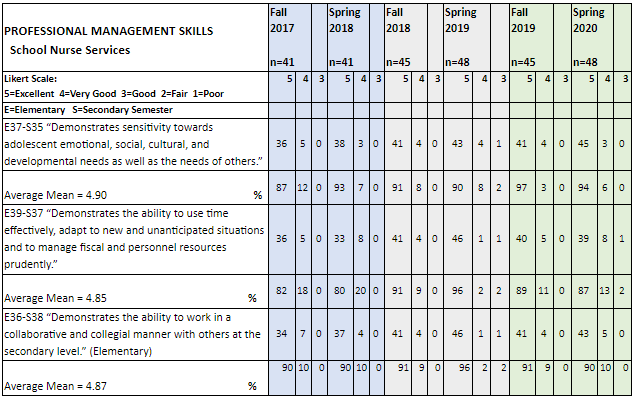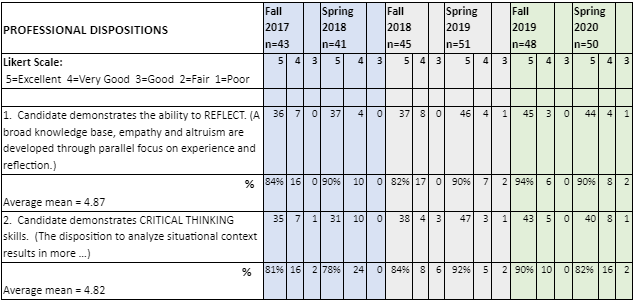AAQEP Accreditation
Standard 1 Aspect F
Standard 1. Evidence shows that by the time of the program completion, candidates exhibit knowledge, skills, and abilities of professional educators appropriate to their target credential or degree, including: Dispositions and Behaviors required for successful professional practice.
Successful School nursing is a dynamic and cyclical profession dependent on critical thinking and reflection of practice. Core components of the school nurse practice include Assessment, Diagnosis, Outcomes Identification, Planning, Implementation, Coordination of Care and Evaluation. Self evaluation of one’s own practice to a professional Standard of Care is essential. School Nurse professional behaviors and dispositions include: Ability to reflect, critical thinking skills, ethical judgement, value diversity, collaborative disposition and enthusiasm for life long learning. This framework of behaviors allows the school nurse to customize to individualized work situations or environments to meet the needs of students, staff and community. Candidates use journals to write reflections about their practice, and reflect on practice in course Discussion Boards and weekly Research Questions. Preceptors assess candidates for professional behaviors and dispositions on two endpoints, Fall and Spring semesters. Any preceptor who feels a candidate does not meet established standards is encouraged to notify the course instructor for consultation. In addition, Program Coordinators review course Professional Disposition and Preceptor Skill Checkoff evaluations mid year to determine candidates who may need more support.
Data Sources & Analysis:
DATA sources to be Introduced:
- Preceptor Checklist of Skills and Competencies-Professional Management (Form P106/P206)
- Professional Dispositions (Form P104/204)
Data Source 1
Midterm and Final Semester Fieldwork Evaluation, Preceptor Checklist of Skills and
Competencies-Professional Management Skills (Form P106/206)
The first measure is the Fall semester (Elementary) and Spring final semester (Secondary)
fieldwork evaluation Preceptor Checklist of Skills and Competencies-Professional Management
Skills, P106/206, used by preceptors to evaluate candidates in their fieldwork knowledge
at two points.
Perspective: Preceptor
Specific Items Used:
- Item 1: E37-S35 “Demonstrates sensitivity towards adolescent emotional, social, cultural, and developmental needs as well as the needs of others.” Example skills from the preceptor checklist: E19 and S24
- Item 2: E39-S37 “Demonstrates the ability to use time effectively, adapt to new and unanticipated situations and to manage fiscal and personnel resources prudently.” Example skills from the preceptor checklist: E11 and S13.
- Item 3: E36-S38 “Demonstrates the ability to work in a collaborative and collegial manner with others at the secondary level.” Example skills from the preceptor checklist: E12, E24 and S5, S26.
Definition of Success:
Candidates are rated on a 5-point Likert scale with a 5 being “Excellent” and a 1
“Poor”. Our hope is to see positive growth between the first and second semester.
The program goal is for all candidates to achieve an Excellent or Very Good rating.

| PROFESSIONAL MANAGEMENT | Fall 2017 |
Spring 2018 |
Fall 2018 |
Spring 2019 |
Fall 2019 |
Spring 2020 |
|---|---|---|---|---|---|---|
| Average Mean Score Combined 2017-2020 | 4.87 | 4.80 | 4.95 | 4.75 | 4.86 | 4.79 |
Summary of Findings
From 2017 to 2020 Mean scores were consistently above average in Professional Management
areas.
E37 and S35 scores on the Professional Management indicators demonstrated 99% of candidates achieved an Excellent or Very Good rating revealing candidates demonstrate sensitivity towards emotional, social, cultural and developmental needs of the school community. One candidate received a Good rating and Zero percent of students received a Fair or Poor rating.
E39-S37 scores on the Professional Management indicators demonstrated that 99% of candidates achieved an Excellent or Very Good rating demonstrating that candidates used time effectively and can adapt to new and unanticipated situations and manage fiscal and personnel resources prudently. Two students received a Good rating and zero percent of candidates received a Fair or Poor rating.
E36-S38 scores on the Professional Management indicators demonstrated 99% of candidates achieved an Excellent or Very Good rating demonstrating candidates work in a collaborative and collegial manner with others. One candidate scored a Good rating and zero percent of candidates received a Fair or Poor rating.
- Mean scores in E37-S35 ranged from 4.88 to 4.93 with an average of 4.90.
- Mean scores in E39-S37 ranged from 4.79 to 4.91 with an average of 4.85.
- Mean scores in E36-S38 ranged from 4.80 to 4.93 with an average of 4.87.
Analysis and Interpretation
Candidates received high marks in demonstrating the ability to use time and manage
resources effectively as well as the ability to adapt to new and unanticipated situations.
In addition, data demonstrates candidates can work in a collegial and collaborative
manner being sensitive to the emotional, social, cultural, and developmental needs
of students, staff, and families in the school community.
Data Source 2
Professional Dispositions (P104/P204)
The second measure is a rating used by the practicum preceptors to measure candidate’s
dispositions. This is a 5-point Likert scale. The professional dispositions survey
rates six dispositions and behaviors required for successful professional practice.
Areas include: Ability to reflect, critical thinking skills, ethical judgement, value
diversity, collaborative disposition and enthusiasm for life long learning. The survey
states: “Please circle on the scale the number that best reflects the most accurate
description of student application of dispositions. Give examples/comments in space
provided.”
Perspective: Preceptor
Rationale for Using:
Professional Dispositions measures behavior needed for successful practice.
Specific Items Used:
- Item #1. “Candidate demonstrates the ability to reflect (A broad knowledge base, empathy and altruism are developed through parallel focus on experience and reflection.)”
- Item #2. “Candidate demonstrates critical thinking skills. (The disposition to analyze situational context results in more informal decision-making. Credential candidates will be practiced in analyzing intra-personal, interpersonal and contextual issues in the clinical/educational setting.)”
Definition of Success:
This measure is a 5-point Likert scale with Excellent to Poor ratings. Our goal is
100% of the candidates will measure an Excellent or Very Good on Dispositions.

| Professional Dispositions | Fall 2017 |
Spring 2018 |
Fall 2018 |
Spring 2019 |
Fall 2019 |
Spring 2020 |
|---|---|---|---|---|---|---|
| Average Mean Score Combined 2017-2020 | 4.93 | 4.86 | 4.80 | 4.87 | 4.92 | 4.85 |
Summary of Findings
Professional Dispositions combined mean score from 2017 to 2020 are rated consistently
high.
From 2017-2020:
Standard 1 data demonstrates 99% of candidates scored an Excellent or Very Good in
the ability to REFLECT. Two candidates scored a Good rating and Zero candidates rated
Fair or Poor.
Average mean of Standard 1 is 4.87.
Standard 2 data demonstrate 97% of candidates scored an Excellent or Very Good in
CRITICAL THINKING skills. Three candidates rated a Good and Zero candidates were rated
a Fair or Poor.
Average mean of Standard 2 is 4.82.
Analysis and Interpretation
Preceptors rate candidates on professional dispositions after working with them in
the school setting one on one, working in collaboration on health related projects
and meetings to discuss issues unique to school nursing. The SNSC program rates candidates
on a 5-point Likert scale. The ability to REFLECT and CRITICAL THINKING skills are
two elements that summarize dispositions needed for all areas of school nursing. In
both areas candidates received scores indicating a mean of 4.87 and 4.82.
Average Means for Disposition areas for all cohorts in 2017-2019 rated a combined average of 4.88 indicating candidates have the dispositions and behaviors which will contribute to their success as school nurses.
Analysis of Standard 1f Findings
Preceptors rate candidates on professional management areas and professional dispositions
after working with them in the school setting one on one, working in collaboration
on health-related projects and meetings to discuss issues unique to school nursing.
The high ratings provide evidence showing that by the time of program completion,
candidates exhibit knowledge, skills and abilities of professional school nurses including
disposition and behaviors required for successful professional practice. School nurses
must be able to transition smoothly between elementary and secondary educational levels
as well as multiple school sites, a variety of ongoing health related programs, and
at the same time monitor unlicensed staff who are providing direct student health
care such as medication administration or specialized physical health care procedures.